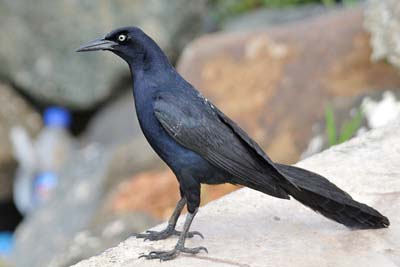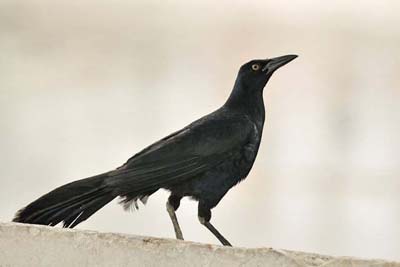
Great-tailed Grackle
Quiscalus mexicanus
Passeriforme Order – Ictéridae Family
BIOMETRICS:
Length: 38-46 cm
Wingspan: 48-58 cm
Weight: 115-265 g
LONGEVITY: Up to 12 years
DESCRIPTION:
Great-tailed Grackle male is iridescent black, with purple sheen on the head, back and underparts. It has a long keel-shaped tail. This species has flat crown.
PROTECTION / THREATS / STATUS:
Great-tailed Grackle benefits to human modifications of the landscape. It is now widespread and abundant. It may help in agricultural pest control, but it has become itself a major pest in urban areas.
Fr: Quiscale à longue queue
All : Dohlengrackel
Esp : Zanate Mexicano
Ital : Gracchio mexicano
Nd : Langstaarttroepiaal
Sd : Mexikobatstjärt
Photographers:
Patrick Ingremeau
TAMANDUA
Tom Grey
Tom Grey's Bird Pictures
Text by Nicole Bouglouan
Sources:
NEW WORLD BLACKBIRDS – THE ICTERIDS by Alvaro Jaramillo and Peter Burke – Helm - ISBN : 0713643331
A GUIDE TO THE BIRDS OF COLOMBIA by Steven L. Hilty and William L. Brown - Princeton University Press – ISBN 069108372X
A GUIDE TO THE BIRDS OF MEXICO AND NORTHERN CENTRAL AMERICA by Steve N. G. Howell, Sophie Webb - Oxford University Press - ISBN: 0198540124
FIELD GUIDE TO THE BIRDS OF NORTH AMERICA by National Geographic Society - National Geographic Society - ISBN: 0792274512
BIRDS OF THE GREAT BASIN – by Fred A. Ryser - Univ of Nevada Pr -ISBN: 0874170796
The Birds of North America online
What Bird-The ultimate Bird Guide (Mitchell Waite)
Wikipedia (Wikipedia, The Free Encyclopedia)
Bird Web (Seattle Audubon Society)

Adult female has brown upperparts. Underparts are paler, buff on breast to greyish-brown on belly. It has less iridescence than male, and is smaller.
Both adults have yellow eyes. They have strong, pointed, long, blackish bill, and dark legs, with strong and large feet.
Juvenile resembles adult female, but less glossy, with streaked underparts and dark eyes.
Chicks are covered with sparse grey down.
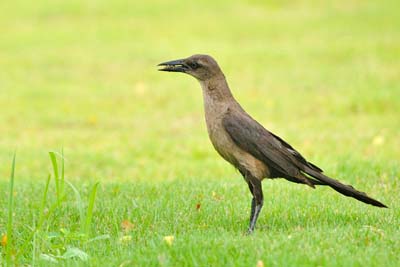
VOICE: SOUNDS BY XENO-CANTO
Great-tailed Grackle has varied calls including clear whistles and loud “clack” notes. We can hear loud wheezy calls, clattering and creaking sounds, short cluck calls and a low-amplitude growl.
Courtship display includes “cheat” and “che” notes.
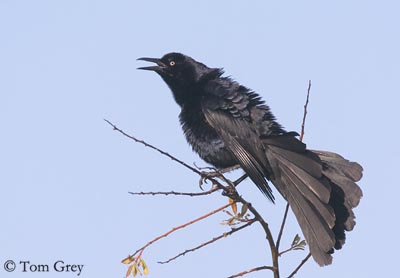
HABITAT:
Great-tailed Grackle is common in open flatlands, with scattered trees, and in marches and wetlands. We can also find it in thickets, farms, towns and urban parks.
RANGE:
Primarily, Great-tailed Grackle was found in Central and South America. But modifications of habitat by human activities have caused the birds to expand their range in United States and Canada (N to E Oregon; Canada; NW Peru; W Arkansas).
BEHAVIOUR:
Great-tailed Grackle forages in large flocks except during breeding season. When wintering, they forage in single sex groups, and follow tractor to get food.
They also roost in large groups. Great-tailed Grackle is resident all year round in its range.
Courtship displays by males include “ruff-out” and songs. Tail is fanned, body feathers are ruffed, and while it is singing, the head is arched upward. It has drooped and quivered wings, or held out toward the sides.

Male courtship display is exaggerated, with bill pointed down, and wings rapidly quivered, while is singing “cheat” notes.
Female responds by drooping and quivering wings, with cocked tail, and singing “che” calls.
Male is polygamous; it has territory including nests of several females and it mates with them. It protects young but does not provide parental care.
Great-tailed Grackle nests in colonies of few pairs to thousands, with nests close together.
Male Great-tailed Grackle is shy, and often remains hidden in tree top, while females forage on the ground. Sometimes, it joins them.
It is a noisy and opportunistic bird.
Male often fights, using their feet or by biting. They fight on the ground, but also in town, in the middle of a street. When they are on the ground, they may walk or run, but never hop.
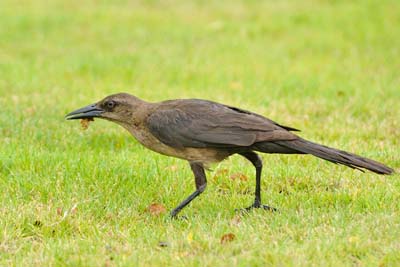
FLIGHT:
Great-tailed Grackle has strong and direct flight, with rapid wing beats.
REPRODUCTION:
Great-tailed Grackle’s nest is hanged among small branches in trees, shrubs or rushes.
It is a cup of woven plant materials, built by female. She will steal nest materials from one another. Nest is made with grasses and small twigs, and lined with fine grasses. They also use man made materials such as paper and plastic.
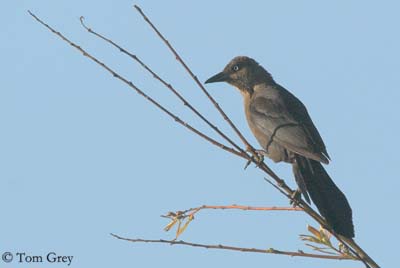
Female lays 3 to 4 bright blue to pale bluish grey eggs, marked with dark. Incubation lasts about 13 to 15 days, by female. Young hatch altricial and are fed by female alone. They fledge at about 20 to 23 days of age.
Young females reach their sexual maturity at one year, but males later.
This species produces one clutch per year, occasionally two.
DIET:
Great-tailed Grackle feeds on insects and other invertebrates, and also tadpoles, lizards, small fish, and plant materials, fruits, grains and seeds. It may eat sometimes eggs and nestlings, and it removes and eats ectoparasites from cattle.
